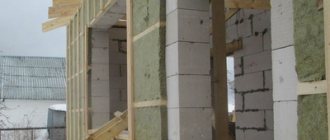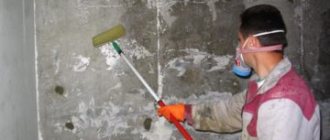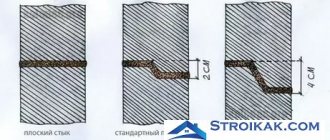Wells made of reinforced concrete rings in our conditions require waterproofing. Waterproofing a well made of concrete rings is a common task, but the reasons for it are different. In water wells made without high-quality insulation, the water becomes polluted and is not suitable for drinking. Special requirements apply to septic tanks to prevent the release of household waste. The restrictions applied to wells narrow the list of materials and techniques for applying waterproofing.
Typically, well rings have locks at the ends. It is these locks that keep the stack of rings from moving relative to each other.
At the very beginning, we need to distinguish between the types of wells that we may encounter:
- Water wells. The well shell can allow grounded, unfiltered water to pass through; along with the water, agricultural products, soil, and much more enter the well. As you can see, high-quality external waterproofing of drinking water wells is important from the moment of construction.
- Sewer wells or septic tanks. Here the situation is the opposite. The hydrobarrier must prevent waste from entering the soil.
- Technological wells represent a vertical descent to some rooms below (usually to the rooms of engineering systems and the like). For such wells, waterproofing is needed to protect against destruction of the well itself and to prevent flooding of the room where it leads. Typically, such protection is mounted both inside and outside.
When installing both a septic tank and a drinking well on the site, remember that there should be at least 15 meters between them and the septic tank should be located lower, if you look at the topography of the site.
The peculiarity of waterproofing a well for drinking water is that the most effective waterproofing materials based on bitumen cannot be used: the taste changes and the materials can be harmful to health.
Let's consider the necessary work on waterproofing a well assembled from concrete rings.
The need for waterproofing
Wells have different purposes, but they can be divided into the following groups:
- containing water for drinking;
- sewer;
- created for technical needs.
All structures must be protected from external influences. It can be caused by groundwater lying close to the surface, and precipitation, which, when it gets inside the tank, contaminates the water.
Wells should not be allowed to freeze. Temperature changes destroy concrete, it becomes covered with cracks, which leads to leaks. Soil particles may get inside.
If a sewer well is made on the site, its seams must be made airtight. In this case, waste and feces will not enter the groundwater through them. A special feature of technological wells is that they are equipped with water taps.
For them to work without failures, there should be no water inside. Laying waterproofing materials will help achieve this. If they are not used, fungal deposits will form on the taps. If microorganisms get inside a technical well, they form deposits on the walls. Because of this, strength is lost. The rings are destroyed and will have to be repaired or replaced.
Reasons for depressurization
Concrete walls underground are constantly under the influence of negative phenomena:
- seasonal freezing and thawing of wet soil. The formed ice contributes to the rupture of the surface of the walls, which leads to inevitable depressurization. It doesn’t take long from the first cracks on the surface to the walls being completely unusable;
- washing out the insulating layer with toxic mixtures with pebbles, sand, organic matter, and particles of caustic substances;
- soil compaction, which leads to a violation of the integrity and chipping of the insulator from the annular joints.
Preventive inspection, timely treatment of seams and loose areas prevents the destruction of the structure.
Types of waterproofing wells
The walls are covered with waterproofing materials inside and out, and the seams must be sealed. When performing work, you should take into account the requirements of SNiP. The list of events is as follows:
- first, the parts of the well are connected into a whole;
- all cracks are sealed with sealant;
- antiseptic or waterproofing material is applied to the interior walls;
- waterproof the seams on the outside;
- the bottom and bottom part are finished with lining materials.
If all the work was done as described in SNiP, the concrete structure will not deform over time. In a septic tank, the soil will be protected from contamination, and when operating well tanks, waterproofing will guarantee that drinking water remains clean.
The taste and color of the water has changed
The process of drinking water turning into a cloudy liquid with unknown impurities and an unpleasant odor usually takes a long time. The main reason is that the waterproofing has ceased to perform its functions or holes have appeared in the reinforced concrete rings. This usually happens gradually, but seismological activity or large-scale excavation work nearby can cause rapid failure of the well.
Waterproofing includes seams between the rings and a clay lock around the head. You can notice their damage with the naked eye. These are evidenced by cracks, sprouted plant roots, various debris, wet streaks on the walls of the well and the formation of shifts in neighboring rings.
To restore the tightness of the joints of the rings, the worker goes down on a safety rope, inspecting and removing unsuitable grout. The well is first pumped out. The cost of sealing joints depends on the scale of destruction, the building mixture used and the complexity of the work. A perforation in a well shaft can be pressure, that is, water flows into it. Ordinary cement mortar is useless in such cases; instant-setting hydraulic seals must be used.
After sealing the seams, the bottom of the well is cleared of debris; if there was a bottom filter at the bottom, it must be lifted up for washing or replacement. This item increases the cost of repairs, so builders do not recommend installing filtration layers in each well, but only when necessary.
Complete disinfection with chlorine-containing preparations is carried out when the well is flooded with sewage or if the remains of a dead animal or rotting vegetation are found inside. In other cases, preventive treatment with less aggressive drugs or weak concentrations of chlorine is recommended.
A more problematic repair case is the displacement of the rings. It is more difficult to seal the opening between them, and there is no guarantee that after a few days the soil pressure will not continue to deform the shaft. For high-quality repairs, it is advisable to reinforce adjacent rings with metal brackets or strips to stabilize the barrel. Then the seams are cleaned, pressed with clay and filled with mortar. Using tow and tarred ropes is an outdated and ineffective method.
Types of materials for waterproofing
Enterprises produce materials that can be applied to the outside of the well, but there are also those that are suitable only for interior decoration. Coating mixtures are widely used; compositions of 2 components are often used to protect the tank from water. Construction stores sell waterproofing in rolls. You can buy mastics, and companies also produce membrane materials.
Types of waterproofing.
Two-component formulations
You can protect your well from leaks using two-component compounds. Once dry, they form a coating that is non-toxic and long lasting. Manufacturers produce waterproofing agents in spray form. The contents are applied to the seam by spraying; the container is equipped with a special nozzle. The composition is used to cover the outside of the concrete structure. The good thing about a sprayer is that it allows you to treat all hard-to-reach places.
Roll materials
If the site is located in a lowland, is often flooded or the groundwater is high, then the quality of waterproofing should be given increased attention. When choosing this method, the outside of the well shaft is finished with rolled materials; their service life is 40 years. Roofing felt is used in the work, but it is increasingly being replaced by insulation and hydroisol; you can also purchase foil-tep and PVC film.
Pasted waterproofing is often used; it is produced in rolls. When producing such waterproofing, a layer of petroleum products is applied to the canvas; it has water-repellent properties. It is covered with a protective film on top and then impregnated. But when choosing rolled materials, it should be taken into account that workers for laying materials must have access to the well shaft from all sides.
Bitumen-polymer based mastics
Mastics containing polymers and bitumen have good performance characteristics. They are used when it is necessary to insulate hydraulic tanks for various purposes.
Bitumen-based materials can withstand sudden temperature fluctuations and high humidity; they are not afraid of the effects of groundwater. Seam sealing made using these materials effectively protects the tank.
Waterproofing with mastic.
Coating mixtures
These mixtures are used when there is excessive soil moisture, when it is necessary to protect the well shaft. The joints are sealed, but before this, a composition is selected and manufactured taking into account the operating conditions of the well.
The amount of material depends on the area being treated; the consumption is indicated in the instructions supplied by the manufacturer. When the mixture is ready, it is applied in a thin layer to the damaged areas. The work is done with a spatula.
Coating mixtures have the following characteristics:
- affordable price;
- ease of application;
- fast hardening;
- formation of a durable layer.
The products differ in that there is no need to prepare the surface before applying them. A layer 2-3 mm thick is applied and then left for 2-3 days, ensuring complete drying.
If you want to save money, concrete rings can be coated with clay. This option is suitable for those who want to do waterproofing themselves. The seams should be carefully coated so that moisture will not seep into the well. A small amount of cement mortar for grouting is enough.
Waterproofing with a membrane.
Membrane materials
For waterproofing concrete structures, membranes created on a polymer substrate are widely used. But such materials work well if polymer-bitumen mastic is used together with them. The disadvantage of the film is its sensitivity to mechanical damage, which leads to a decrease in the effectiveness of protection.
Mixtures based on astringent minerals
If cracks are visible on the surface of concrete rings, use special mixtures with a restoring mineral component. They fill voids, protecting the tank from moisture penetration.
To apply the mixture, special equipment is required; the work is carried out under high pressure. This method can be used to finish the inside and outside of well rings.
If a leak is found inside the well, a mineral membrane is used to fix it. If the walls are slightly damaged, this material can be replaced with water-repellent paint.
Selecting and installing a pump for water supply at home
The choice of a surface pump is more preferable if we evaluate the issue from the point of view of routine repair and maintenance of the unit, which is much more convenient to carry out in a heated basement room than to remove it from the well each time. Water supply to a country house from a well using a surface vacuum pump is limited by the suction depth, the maximum value of which is 9 meters. If the distance from the level of the suction pipeline to the intake end of a flexible water pipeline lowered into a well is greater, a surface pump with a remote ejector or a submersible model of the unit is required.
Water supply system with surface pump
The suction depth of the pump depends on the method of laying the water pipeline adopted for water supply from the well, and is proportional to the depth of the trench for laying the water pipeline and the installation elevation of the surface unit. That is, if the floor level of the basement of a country house, in which the vacuum pump and related equipment is located, is two meters below the ground level, then by laying a water supply system and making an insert into the reinforcement of the well shaft in the horizon with a suction pipe, you can get water from the depth up to 11 meters instead of 9.
According to its characteristics, water supply to a country house from a well, carried out at a depth coinciding with the level of the basement, is also justified by the fact that the water pipeline will be located below the soil freezing mark, which means it will not require thermal insulation and heating to prevent water from freezing in winter. For the coldest regions of Russia, the depth of soil freezing reaches 2 meters, therefore, by making a trench a little deeper, which will correspond to the level of the basement floor, which can reach a height of up to 2.5 meters, the owner of a garden property is guaranteed to prevent freezing of water in the pipes.
Concrete well waterproofing technology
Waterproofing compounds are applied both from the inside and outside. Particular care should be taken to isolate the joints; in addition, the entire internal surface can be treated.
When performing work, use a metal brush. The putty is applied using a spatula, and liquid compounds are applied with a brush. To make them hold better, they do strobing, so it’s worth purchasing a grinder or other tool.
Cleaning joints
Before starting work, the joints are cleaned. If necessary, they are deepened by making grooves that are U-shaped. The prepared areas are cleaned of dust and dirt. At the end of the work, the seams are washed well with water.
Preparation of the treated surface
The quality of the repair depends on the adhesion of the concrete surface. To make the connection stronger, you need to clean it from cement deposits and remove traces of chemicals. If you do not do this and immediately apply waterproofing, the effectiveness of its protection will be reduced.
Applying waterproofing to joints
If you decide to use a primer, then the joints are pre-moistened. After applying the composition and its complete drying, you need to treat the grooved channels. For this, coating materials are used, and the layer thickness should not exceed 30 mm. Insulating compounds for protective purposes are applied 2-3 times.
Applying mastic to joints.
When work is carried out at the construction stage, all joints are taped. This can be done with water-repellent tape. In places where utility networks will be connected, sealant compounds are used.
At each stage of construction, it is necessary to control the tightness of the seams between the rings; the check is carried out from the inside and outside. It is unacceptable for them to have voids, cracks or other damage.
Applying insulation to the surface of concrete rings
The final step in sealing a well is to apply insulation to its interior. First, the walls are sanded, after which polymer mastic is applied to them. It is enough to cover the tank with 2-3 layers of material. Each subsequent one can be applied only after the previous one has completely dried.
Particular attention is paid to the place where the bottom part connects to the first ring of the concrete well. Waterproofing must be of high quality, then there will be no leaks.
Construction of a clay castle
Waterproofing a well is a complex undertaking, so it would also be a good idea to build a so-called clay castle around the well. Its essence is that clay is laid along the perimeter of the external concrete walls. The purpose of the clay castle is to protect the well shaft from the penetration of surface and waste water.
A clay castle is not needed if there is stone, sand, or peat after the fertile soil layer. In this case, only rain and melt water must be drained, which in turn prevents surface water from entering directly into the storage part of the well.
Preparing clay for a clay castle
Experts recommend making a clay castle at the end of May. After the soil near the walls of the well has settled and dried out a little, you can move on to the final stage of constructing the well.
The clay castle is made to a level just above ground level. You can lay tiles or crushed stone on top around the well.
Work on arranging a clay castle should be carried out in dry, warm weather. In this case, the soil most often used is the one that remained during construction. The clay must be selected very carefully: there should be no stones or sand.
Initially, the top fertile layer of no more than 1-2 m around the well is removed. Tamping is carried out in several successive stages. Each stage consists of creating a thin clay layer with a slight slope in relation to the walls of the well.
The clay is wetted and firmly compacted into a small ball that fits in the palm of your hand. So, ball by ball, the clay is laid along the walls and pressed tightly. Such clay does not allow water to reach the walls, but causes it to flow to the sides.
In order for the laying of clay to be carried out with maximum effect, the thickness of each layer should be maintained at 12-15 cm. The initial layers of clay must be compacted very well. The dimensions of the clay castle should be in the range of 2 to 3 meters from the walls of the well.
Video: clay well castle
How to prevent well rings from moving in the future
The reason for the movement of concrete structures is weak soils, so before starting construction you need to determine the type of soil on the site. To prevent elements from moving horizontally, reinforced concrete modules with locking connections can be used instead of rings.
To save money, you can take standard concrete structures, make holes in them with a drill, and then drive in metal brackets, with their help you can connect the rings to each other. If they are not there, you can install metal plates, but they are placed on 2 sides. Bolts are used for fixation; their diameter must be at least 12 mm.
If the site has heaving soils, then the concrete elements are installed so that the bottom one is located below the freezing point. Instead of cylindrical modules, it is better to use conical ones.
Polymer cement mixtures
The harmlessness and effectiveness of polymer-cement mixtures allows them to be used both for external treatment of concrete rings and for waterproofing a well from the inside. These two-component products contain cement, polymers and components to improve elasticity. For good adhesion to the surface of well rings, preliminary cleaning and priming are required.
Advantages:
- elastic and durable protective coating;
- seamless layers of waterproofing;
- environmental friendliness, harmlessness;
- ease of use.
Purpose – internal and external waterproofing.
Polymer-cement mixtures can also be used to strengthen joints between concrete rings.
Additional work
According to SNiP, not only the walls of the structure are subject to insulation, but also its bottom. A plate with a ridge is mounted on the bottom, which ensures correct alignment of the last ring. The joint between the slab and the walls of the well must be insulated. Waterproofing the bottom of a well can be done in several ways:
- Before installing the lower ring, a waterproofing cord is laid on the slab. It consists of special granules that expand under the influence of water, thereby reliably filling all the gaps.
- To insulate the bottom of a communication well, you can use rolled material. To do this, the bottom is cleared of debris and treated with bitumen mastic. After this, strips of roofing felt are glued to the walls to a height of 10-15 cm. Typically, roofing felt is laid in 3-4 layers. After this, the bottom is additionally covered with gravel. Layer height 10 cm.
- Also, the seams between the bottom and the walls can be sealed with a repair compound. To do this, first apply the first layer of the mixture, then glue the joint with waterproofing tape, and then apply a second layer of coating.
Pay special attention to sealing the seams between the rings
Concrete compacted in a factory almost does not allow water to pass through; we can only talk about capillary penetration if the products are of high quality. Practice shows that in wells assembled from standard concrete rings, leaks occur mainly due to leaky seams
It is important even at the installation stage to ensure that the seams between the rings are filled with mortar. It is mixed using Portland cement and sifted sand in a ratio of 1:3
The result will be much better if you add Penetron Admix to the mixture, it will give the solution waterproofing properties.
Careful sealing of seams is an indispensable condition for high-quality waterproofing











